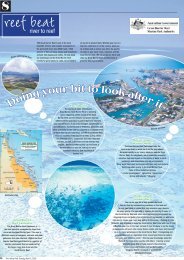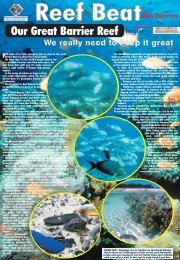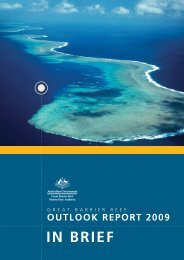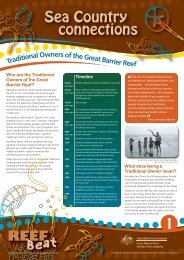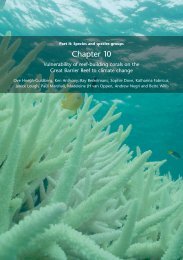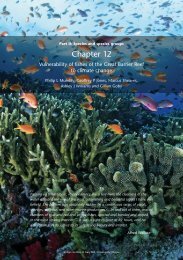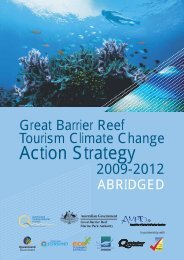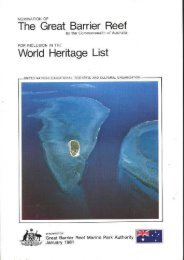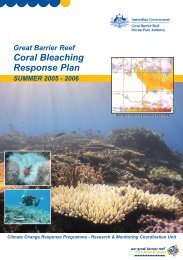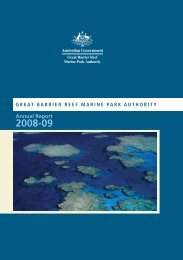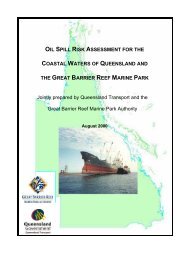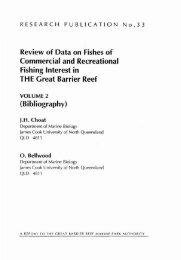ACTIVITIES BOOK - Great Barrier Reef Marine Park Authority
ACTIVITIES BOOK - Great Barrier Reef Marine Park Authority
ACTIVITIES BOOK - Great Barrier Reef Marine Park Authority
Create successful ePaper yourself
Turn your PDF publications into a flip-book with our unique Google optimized e-Paper software.
Discussion: Concluding discussions should focus on the concept ofcompounding impacts. The summer of 2009 provided an excellentexample of compounding environmental impacts on reef corals. Studentscan visit the GBRMPA media centre to read about how the combination ofcyclone Hamish, higher than average sea temperatures and freshwaterrun-off affected the <strong>Reef</strong>. Read media release ‘Weather triple whammyroughs up the <strong>Reef</strong>’ atwww.gbrmpa.gov.au/corp_site/info_services/media/media_archive/2009/2009_03_18. Students can think about the combined impacts ofhuman pressures in a similar way.Activity 2: Creative exercise on coral bleachingKey learning objective: Students will understand the process andimplications of coral bleaching using a ‘learning by teaching’approach. By developing their own ways to explain this complextopic, they will gain deeper insight.Background: Coral bleaching occurs when corals becomestressed. A bleached reef is essentially a sick reef. While they canrecover, bleached corals can also die. Coral bleaching is one of themost worrying impacts climate change will have on the <strong>Great</strong><strong>Barrier</strong> <strong>Reef</strong>. If corals bleach more and more frequently, theirchances of recovery diminish and the overall health of the entire reef system declines.Bright idea: Showstudents the GBRMPAanimations ‘Coralbleaching’ 1 and 2(provided on <strong>Reef</strong> BeatDVD) and give a short quiz to testwhat they have learned. Here aresome example questions: Where docorals get most of their energyfrom? (answer: the sun or theirzooxanthellae). Corals have asymbiotic relationship orpartnership with zooxanthellae.What happens when corals get toohot? (answer: their zooxanthellaemove out, the corals lose theircolour and can die.) What willhappen if climate change makes ouroceans too warm for corals?What you will need:1. butcher’s paper2. textas3. craft items (e.g. plasticine, fabric scraps, bits of rubbish and other items the studentscan use creatively)Instructions: Using the theory of multiple intelligences, ask students to compose a creative piece of materialon the topic of coral bleaching. They may use one or more of the following prompts to explain what coralbleaching is, to describe who, what, and where it has an impact and to develop ideas on what we can do tohelp stop or slow it:words (linguistic intelligence)Write a story, poem, report or short speech about coral bleaching. Perhapsuse this to teach another class about it.numbers or logic (logical-mathematical intelligence)Using ocean temperature information, as well as information on the <strong>Reef</strong> foundonline and in zoning maps, calculate the area of <strong>Reef</strong> likely to beaffected by bleaching either across the whole reef or just in onesection.pictures (spatial intelligence)Create a model, a map or a cross-section of the <strong>Great</strong> <strong>Barrier</strong> <strong>Reef</strong> explainingareas most likely to be affected by bleaching, including its effects on the foodchain.5<strong>Reef</strong> Beat 2009 - Climate Change and the <strong>Reef</strong>



